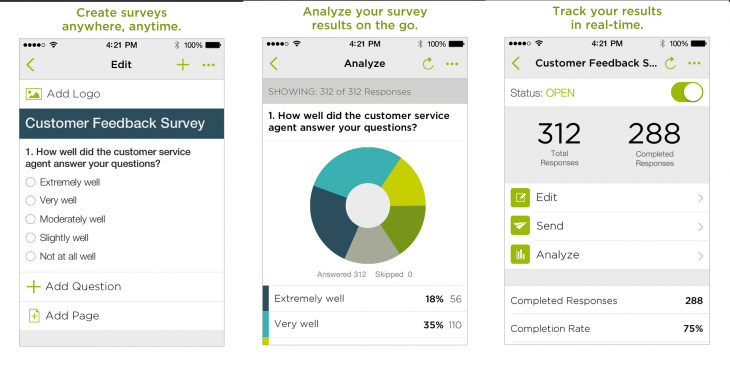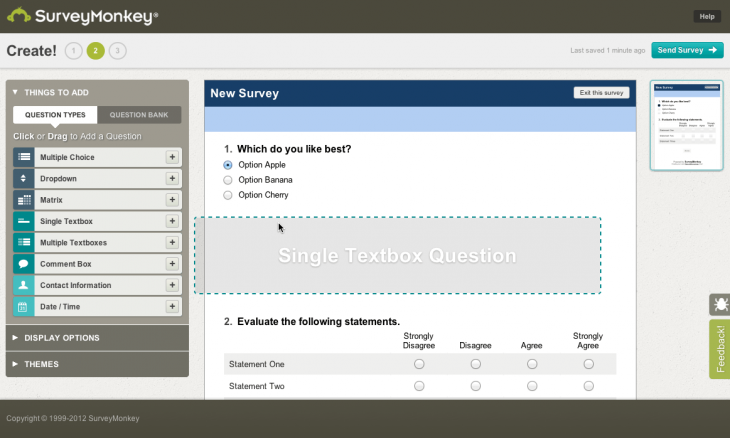
SurveyMonkey has its eye firmly set on Asia.
In an interview with TNW on the sidelines of Social Matters in Singapore, SurveyMonkey CEO Dave Goldberg told us that the online survey tools provider is taking steps to “make Asia what could be (its) biggest market eventually” — namely localization, as well as a launch for Android which dominates over iOS in many parts of the continent.
SurveyMonkey finally launched its iOS app in February this year, 14 years since the start of its business. Goldberg had noted back then that the company has seen a 14 times increase in its mobile traffic over the past three years.
However, the Android app is still in the works. Goldberg was hesitant to pin down a specific timeline, but said that both the app and localized versions of SurveyMonkey would likely be in place by next year. “It’s very much a priority for us,” he said.
It’s hard to ignore (Asia) — it’s a huge portion of the world’s users and we’ve seen tremendous interest already. Every time we make it easier for our customers in Asia, with languages or 24/7 customer support so it works timezone-wise… we get more usage, we get a lot of people taking up the service more. So we think there’s a lot of potential…
We’ve done a lot of work in South America and Europe, but I think in some ways Asia has the biggest potential for us, so that will be the big push. But we have to get through a few other things first, and we do feel like the Android version of the app is pretty critical for Asia (as far as the big markets go).
In terms of market share, Android is largely dominant across Asia. Statcounter, an Internet analytics platform based on three million websites, gives the Google-owned platform the lead in most parts of Asia and that’s largely reflected by other research.
SurveyMonkey recently announced that it was opening its first Asia-Pacific office in Sydney, what it terms the “largest international investment” outside of the US and Europe that it has made to date.
In conjunction with this, Australia will also be getting the full range of the company’s products including SurveyMonkey Enterprise and SurveyMonkey Audience.
Goldberg told TNW that Australia was a first step for the company in the Asia-Pacific region because it forms its third-largest customer base, following the US and UK — where it has also announced it will be opening an office. He said that SurveyMonkey will open another Asia office, likely in the next 12 months, as it commits further to this region.
Part of the reason why SurveyMonkey is escalating expansion efforts is because the company released its enterprise product in November 2013. Goldberg explained that its core business doesn’t require staff on the ground, as customers simply come onto the site, start using it for free, then some move on to a paid product. With the enterprise version though, SurveyMonkey needs to hire staff to work with organizations.
“We’ve been taking sort of a slow approach but now that we have this enterprise product, we can hire sales people to sell it and that can make it easier for us to expand more in Asia,” Goldberg said.
When asked to shed more light about SurveyMonkey’s competition in Asia, Goldberg noted that every country has a couple of similar services, particularly in China. However, he thinks that SurveyMonkey has built up a certain level of trustworthiness over the past 14 years, and “it’s hard for (rivals) to get traction because they don’t really offer something that’s different than what we offer.”
China is also SurveyMonkey’s next big project, Goldberg revealed, but Southeast Asia will come first because it’s not as difficult to crack as China. This stems from the fact that SurveyMonkey doesn’t have servers inside China, which affects the performance of its survey tools. It also explains why SurveyMonkey is not available in Simplified Chinese, which is the default language in mainland China, but only in Traditional Chinese, which is used typically by people in regions including Taiwan and Hong Kong.
We’re not in Simplified (Chinese) because we don’t really want to give the impression that you can easily use us inside of mainland China. Because we’re not inside the Firewall — people do use us and we have customers there — but we felt if we went into Simplified but we were still serving from outside China, that people would have an expectation that the quality of it was going to be better than it is.
It works — we’re very low bandwidth, you can take SurveyMonkey surveys on dial-up, it’s fine — but there’s still an expectation more from the survey creator that the tool would be fast and all sorts of things. We’ve tested it from inside of China right now, it works but it’s not where we would deem it to be acceptable. Eventually we would need to set up servers inside of China and do that, so we haven’t got to that part of it yet.
We talk to enough people who say: your experience needs to be great inside of China if you’re really going to try to convince people to pay you. if it’s free, people are fine and they’re okay, but if you’re going to convince people to pay you and give you money, you need the service to be really, really good.
Goldberg revealed that expansion plans for SurveyMonkey have only kicked into gear recently because it took time to build up a team, followed by the technology infrastructure that yielded a series of new products, including APIs for its mobile app and the mobile feedback SDK.
He said that more new products and new ways to use existing SurveyMonkey products will be coming soon, and this is also why we can expect the company to step up efforts in making its presence felt in even more countries around the world. The journey for this 14-year-old company seems to be just starting, particularly in Asia, aided by its new efforts on mobile as well.
Headline image via Shutterstock
Get the TNW newsletter
Get the most important tech news in your inbox each week.








